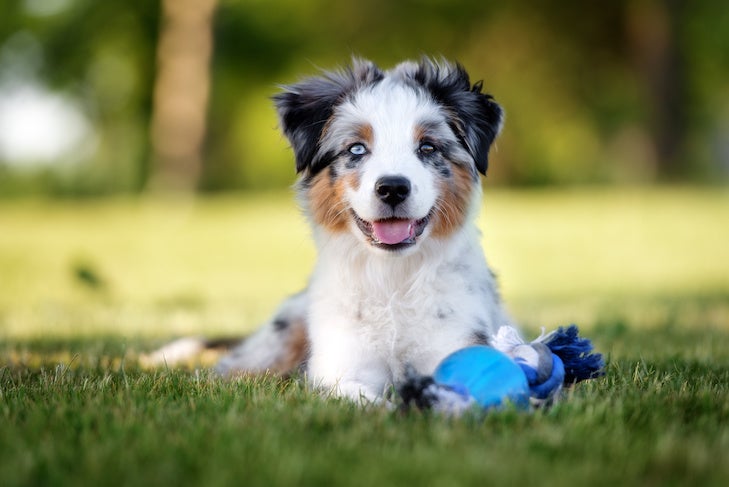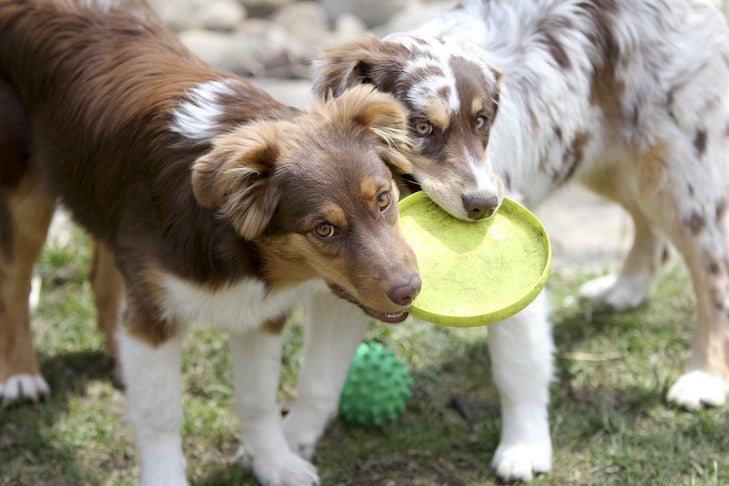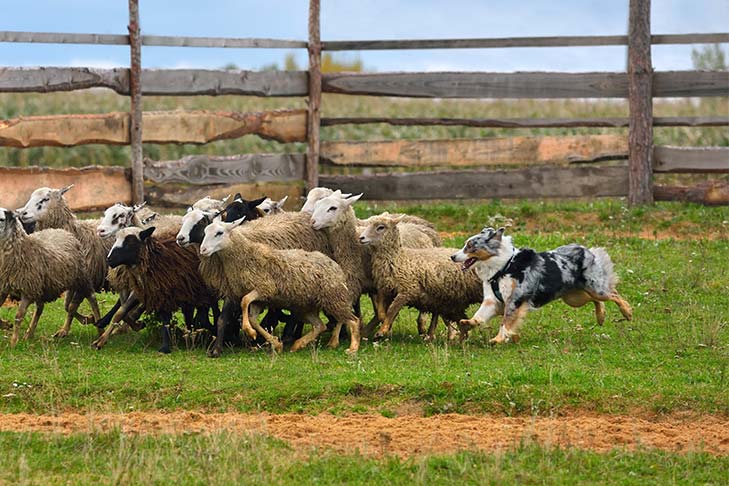
To help you navigate your Aussie puppy’s first year and beyond, we turned to Dr. Peggy Timm, AKC Australian Shepherd owner and owner of Lake Forest Animal Clinic.
Growth Stage: Between 8–16 Weeks
Training goal #1: Work on basic cues and set rules
Aussies are smart and energetic dogs who are eager to please and need mental stimulation. When your Australian Shepherd is a puppy, it’s important to exercise both their brain and body. To start, teach your dog the basics.
“You want to work on them knowing their name, basics like sit and down, starting recalls with a very positive attitude, and walking on a leash nicely, and just kind of getting to know them and them getting to know you,” said Dr. Timm.
Dr. Timm reiterated the need to keep an Aussie’s brain working and thinking. “If you don’t teach them what you want them to do, they’re going to learn something else and it won’t be what you want them to do because they’re really smart and learn really quickly,” she added.
If you have any household rules, she suggests setting boundaries and rules early. “It’s better to set those standards when they’re young. It can be very confusing to dogs to change the rules halfway through,” she said.
Training goal #2: Socialize your Aussie
When your Aussie is a puppy, it’s important to socialize and expose them to new people, places, sounds, surfaces, and dogs. A well-socialized puppy becomes a kind, friendly, and well-adjusted dog.
“Make sure they can safely be exposed to other dogs that you know are healthy and vaccinated,” Dr. Timm says. “I wouldn’t take them at that age to a public place where you don’t know about the other animals that are there.”
To help socialize your pup, consider enrolling him in the AKC S.T.A.R. Puppy program where he can learn manners and socialize with others.
Training goal #3: Housebreaking and Crate Training
Like with all puppies, you should start potty training your Aussie on the very first day home, and crates are an important tool in the process. Before you even pick up your Aussie, you should have a plan and schedule in place for potty training. After all, consistency and patience are key.
When you’re potty training, choose a designated potty area and take your pup there each time. Puppies have small bladders and have to pee often. Maintaining a regular schedule is also critical to house training success.

Puppy Stage: By 6 Months
Training goal #4: Perfect the basics with your Aussie
When your Aussie is 6 months old, they should have almost all the basics down. However, these dogs are smart and are never done learning.
“By 6 months, I think that they should be well on their way to be potty trained, they should be comfortable in their crate, they should be comfortable with you being able to leave them in the crate by that age, they should know basic cue such as sit, down, they should have a pretty good start on their recall,” Dr. Kimm said.
At this age, Aussies should be able to walk on a leash nicely. While they should be close to perfecting the basics, Dr. Kimm still suggests using treats and other aids to help you accomplish these things.
Dr. Kimm said one thing that makes Aussies different from other dogs is that they don’t like repetition. “If you’re doing things over and over again, it doesn’t mean they’ll continue to do it the same way,” she said. “Once they get it right, if you keep asking for the same behavior, they’ll often change it because they don’t think they were correct.
Training goal #5: Exercise your Aussie’s body and mind
When you’re exercising your pup, it’s important to include both mental and physical exercises.
“An Aussie should get a good amount of exercise every day, especially as they’re young,” Dr. Timm said. This includes daily walks and more for the active breed.
In terms of mental exercise, Dr. Timm said that any kind of early learning is great. “I like to teach my Aussie puppies things they can do with a box — they can get in the box, they can drop their toys in the box, they can sit and lay down in the box, it just gives them a little bit of focus on what you’re trying to get them to do,” she added.
There are also fun Treiball activities you can play in your backyard or living room. While it’s important for your Aussie to get exercise, you’ll want to stick to low-impact activities until your dog is fully grown.

Growth Stage: By One Year and Beyond
Your puppy should know basic cues, be comfortable being alone, and have a daily routine by their first birthday.
Training goal #6: Get your Aussie involved in AKC activities
Aussies can participate in a range of AKC activities but excel in events such as agility, obedience, and herding. With an Aussie’s boundless energy, channeling it into something constructive can do wonders for your dog.
These dogs bond strongly with their families. Their loyalty with their intelligence and high energy makes them very easy to train. Regardless of the activity, your dog will love doing it with you.
Training goal #7: Be patient and consistent with your Australian Shepherd
Aussies are eager to please, but if you’re not consistent it’s hard for your dog to know how to behave.
“If it’s a family situation, everyone has to agree on what those standards are going to be because otherwise, the dog isn’t going to learn,” Dr. Timm said. “Everyone has to be on the same page on how they’re going to treat the dog.”
Dr. Timm said consistency and patience are key, especially, if your dog struggles later on. “I find at a year and half of age, these dogs revert back to having problems like they did when they were puppies,” she added. “I kind of say it’s their teenage phase. So don’t ever be afraid to revisit your foundation skills. Sometimes they just need a reminder.”

